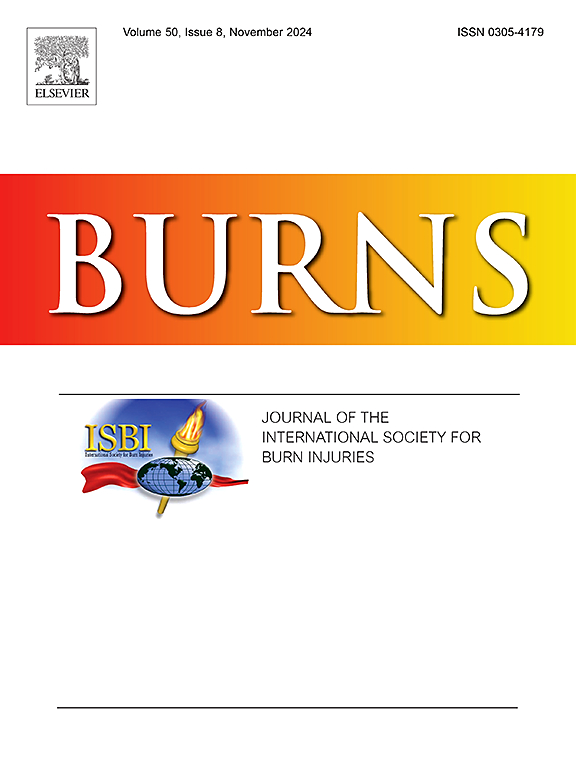成人和儿童烧伤疼痛管理:烧伤护理提供者的全球调查
IF 2.9
3区 医学
Q2 CRITICAL CARE MEDICINE
引用次数: 0
摘要
烧伤疼痛管理的实践可能因地区或社会经济地位而异。本研究旨在评估目前全球烧伤患者的疼痛管理实践。方法通过电子邮件向国际烧伤学会(ISBI)成员发送一份关于烧伤疼痛治疗药物可用性和使用情况的在线调查,并在由烧伤专业人员组成的WhatsApp群中分享。主要结果是提供全球烧伤疼痛管理现状的累积代表。完成了113项调查,其中一半的受访者来自高收入国家。大多数应答者同时治疗成人和儿科患者(65% %)。对所有烧伤大小的背景痛使用最多的镇痛药是扑热息痛,hic比其他国家更频繁地使用它来治疗大小烧伤(p = 0.03和0.02)。口服和静脉(IV)阿片类药物更常用于HICs中所有烧伤大小的成人患者。有疼痛管理协议或了解疼痛指南的受访者报告说,他们的病人感觉疼痛控制得更好。结论烧伤的疼痛管理因国家社会经济状况和药物可及性而异。充分控制疼痛的感觉与社会经济地位、药物的可获得性和是否有疼痛治疗方案有关。本文章由计算机程序翻译,如有差异,请以英文原文为准。
Adult and pediatric pain management for burn injuries: A global survey of burn care providers
Introduction
The practice of pain management for burn injuries may vary by region or socioeconomic status. This study aimed to assess current pain management practices in burn patients globally.
Methods
An online survey regarding the availability and use of drugs for burn pain management was sent to members of the International Society for Burn Injuries (ISBI) via email and shared in WhatsApp groups comprised of burn professionals. The primary outcome was to provide a cumulative representation of the current state of burn pain management globally.
Results
113 surveys were completed, with half of respondents from high-income countries (HICs). Most respondents treat both adult and pediatric patients (65 %). The most used analgesic for background pain for all burn sizes is paracetamol, with HICs using it more often than other countries for large and small burn sizes (p = 0.03 and 0.02). Oral and intravenous (IV) opioids are more often used in HICs for all burn sizes in adult patients. Respondents having a protocol for pain management or being aware of pain guidelines reported better perceived pain control for their patients.
Conclusion
Pain management for burn injuries varies by country socioeconomic status and drug availability. Perception of adequate pain control is associated with socioeconomic status, availability of drugs, and having a pain protocol.
求助全文
通过发布文献求助,成功后即可免费获取论文全文。
去求助
来源期刊

Burns
医学-皮肤病学
CiteScore
4.50
自引率
18.50%
发文量
304
审稿时长
72 days
期刊介绍:
Burns aims to foster the exchange of information among all engaged in preventing and treating the effects of burns. The journal focuses on clinical, scientific and social aspects of these injuries and covers the prevention of the injury, the epidemiology of such injuries and all aspects of treatment including development of new techniques and technologies and verification of existing ones. Regular features include clinical and scientific papers, state of the art reviews and descriptions of burn-care in practice.
Topics covered by Burns include: the effects of smoke on man and animals, their tissues and cells; the responses to and treatment of patients and animals with chemical injuries to the skin; the biological and clinical effects of cold injuries; surgical techniques which are, or may be relevant to the treatment of burned patients during the acute or reconstructive phase following injury; well controlled laboratory studies of the effectiveness of anti-microbial agents on infection and new materials on scarring and healing; inflammatory responses to injury, effectiveness of related agents and other compounds used to modify the physiological and cellular responses to the injury; experimental studies of burns and the outcome of burn wound healing; regenerative medicine concerning the skin.
 求助内容:
求助内容: 应助结果提醒方式:
应助结果提醒方式:


